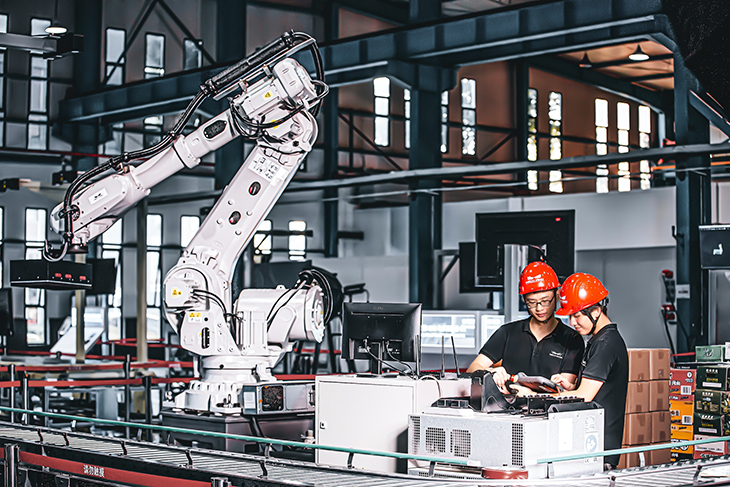Industry 4.0 initiatives are pushing manufacturers to embrace more smart equipment than ever. Human-machine interfaces (HMIs) — the features that let users control machinery — are a critical but often overlooked aspect of this shift. If you want to make the most of your Industry 4.0 strategy, you should consider the advantages of HMIs and related best practices more carefully.
Advantages of HMIs
When many people think of new industrial machines, they think of automation. Automated machinery has many benefits, but it’s also important to ensure human users can interact with and control equipment.
Studies have found that processes are most efficient and least accident-prone when a team of humans and robots work together rather than either by themselves. HMIs enable that collaboration. When employees can easily step in and control machinery, the line can achieve better results than an entirely automated or entirely manual alternative.
Safety is another important advantage of HMIs. Contact with objects and equipment is the most common cause of injuries in manufacturing, so employees must take care around heavy machinery. A user-friendly, well-functioning HMI enables quick responses to emergencies and easier control over potentially dangerous parts, reducing accidents.
How to Select the Best HMI
Capitalizing on the advantages of HMIs requires careful selection and implementation. A subpar HMI will hinder operations more than it helps. With that in mind, here’s how you can select the best HMI for your machinery.
1. Consider the Machine’s Location
The first step in choosing an HMI is considering where you’ll use it. If it controls a machine in a loud environment or near heavy material handling processes, it needs to be fairly rugged. Similarly, beverage factories should opt for water-resistant interfaces.
You should also consider visibility within the area of interest. Glossy screens may be difficult to read in rooms with inconsistent or dim lighting. It’s also important to place the HMI where operators can see and access it easily. To do that, you must consider any physical space restraints. Tighter facilities may need more compact HMIs to enable safe, easy access.
2. Aim for Ease of Use
If you want to take full advantage of HMIs, these interfaces must also be user-friendly. If an HMI has extensive functionality but is challenging to learn and difficult to control, it may cause more problems than it solves by introducing more human errors. Consequently, you should look at user reviews and product descriptions carefully to find easy-to-use interfaces.
Button size, display readability and controls that resemble those on equipment workers are already familiar with all impact usability. If you need multiple HMIs, consider options where a single interface can work with various device types. Operators may have to help on different lines amid staffing challenges, and a common interface makes that transition easier.
3. Take Ergonomics Into Account
Similarly, your HMI should be ergonomic. Controlling an HMI may not seem strenuous initially, but if it requires awkward hand positioning or repetitive, small motions, it can cause serious issues. Over time, operators may develop musculoskeletal injuries, and discomfort hinders ease of use and efficiency.
Ergonomic injuries are the most common cause of nonfatal injuries leading to days away from work, causing more than 47,000 incidents in 2019 alone. Poor ergonomics will also result in inefficient operation and make user errors more likely. To avoid these situations, see if you can test HMIs before implementing them to ensure they’re comfortable.
4. Ensure Compatibility
Choosing the right HMI also means finding one that supports the same connectivity options as the machines you’ll use them with. Checking compatibility is straightforward and quick, but it’s easy to overlook when you’re focused on other considerations. To make your search easier, check your machines’ communication ports and supported software before looking for HMIs.
Cable connections are the most common type today, but you may be able to use wireless options, too. Internet of Things (IoT) connectivity opens up more placement possibilities, but it also means you must ensure everything uses the same IoT protocol. There are dozens of wireless connectivity standards today, so you may be able to choose from multiple supported options.
5. Don’t Overlook Longevity
Finally, remember that HMIs can be expensive, so you want an option that will last you as long as possible. Consider all of the environmental factors yours must withstand, like moisture, vibrations or physical shocks. You must also consider the longevity of components within the HMI itself, such as its screen’s LCD life expectancy.
Taking full advantage of HMIs means using them for as long as you can. Depending on your other needs, you may want to sacrifice some newer features for a longer service life to enable that.
Capitalize on the Advantages of HMIs
HMIs have many advantages when implemented properly. Once you know how you can get all you can out of these devices, you can find the best one for your operations.
Like any other machine, there’s no single answer to which HMI is the best. It depends on your specific needs and use cases. If you follow these steps and understand what you need, you’ll be able to maximize your HMI ROI.

























